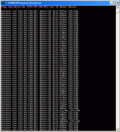I have never been to Sweden before, but judging from Ram Krishnan's report on his blog and the pages on Sweden on the prepaid wireless internet wiki, it seems the situation there concerning mobile broadband use is similar as in Austria: Affordable prices and prepaid SIMs that make it easy to go online with a 3G USB stick have made the mobile broadband market surge in the past 18 months. Ram quotes from the 2007 Swedish Telecommunications Market Report of the National Post and Telecom Agency (PTS), available in English here, on the uptake of mobile Internet access in Sweden. Here's my interpretation of the facts and figures:
Only 1% use mobile broadband as their only Internet access
If you have some time, take a look at diagram 8 in the report and Chapter 5 in general, there are some very interesting facts: The diagram shows that at the end of 2007 there were about 375.000 mobile broadband users, up from only 90.000 a year earlier. That compares to about 3 million DSL users and a population of around 10 million. The report says on page 39 that of 2.000 people questioned, only 40 said that they used the 3G dongle at home to complement another access method and only 20 (i.e. = 1%) said that the 3G dongle was their only Internet connectivity at home. So these numbers clearly point out that 3G Internet access is currently used mainly as a supplement to fixed line Internet connectivity. The report also says that since this is a relatively new phenomenon and that it remains to be seen if 3G will remain mainly an add-on to fixed line connectivity at home or if it will seriously start to compete with DSL.
500MB on average per user per month
Diagram 8 says that 375.000 users generated a traffic of 2.200 Terabyte (in the whole of 2007 ?). If you do the maths that amounts to (2.200.000 GByte / 375.000 users / 12 months = 493 MBytes / month.
How Close Are We To Saturation?
So how much is this in practice, how close are we to network saturation? I guess that's quite easy to say for someone who has access to the data of mobile operators. But I don't have that, so let's do a little extrapolating to get an idea of where we might be here with a bunch of assumptions: Let's say the number of people covered by a single 3G base station is roughly the same as a 2G base station, 2000 people. 375.000 broadband users compared to a population of 10 million is 3.75% of the population. Let's double that value to 7% to account for unequal 3G network distribution. 7% of 2000 people are 140 people per cell with a 3G card. Let's say the base stations usually have 3 sectors, and each sector gives an average throughput of 2 MBit/s. That's 6 MBit/s in total. Let's say busy hour accounts for 10% of the daily traffic of 500 MB * 140 people / 30 days / 10 = 233 MB/hour/base station. The capacity of the base station is 6 MBit/s * 60 seconds * 60 minutes / 8 bytes = 2700 MB/hour (minus the capacity used for voice calls).
The above calculation brings us at less than 10% of total available capacity of a base station today. But the input parameters used are highly speculative so the number could easily be half of that our it could be double. If anyone has a different opinion, please let me know.
How Much Traffic Growth in 2008 And Beyond?
This of course opens up the big question of how the growth will continue. When taking the 2006 numbers from the report, an average user consumed 200.000 GByte / 90.000 users / 12 months = 185 MByte / month, i.e. less than half of that of 2007. So this year's traffic and that of the following years will depend on:
- How many additional users can be signed up
- Do these users have the same usage patterns as the users today, or more, or less? Potentially, falling prices could attract users with less usage and only very occasional use but also other groups with little money but high Youtube desire.
I think the numbers are hard to predict since the user behavior and clientele will change. While I think that at this point Generation Youtube is not yet on a 3G stick, I wonder what will happen once they do?
The report references a forecast for 2008,
which reports another 140.000 3G USB sticks have been sold in the first
quarter 2008 and which expects 600.000 users by the end of 2008, an
increase of 40% over 2007. This is impressive but definitely a slowdown over the growth observed between 2006/07.
If we stick to the numbers above, we should still be way clear of the capacity limit for 2008. Same for the year after if another 300.000 subscribers are added. If the amount of traffic per user grows by a factor of two in that time frame and the network stays the same, data traffic would grow to 933 MB/base station/h in 2010, still clear of the capacity limit.
Once the limit of current deployments are reached, operators have a number of options:
- Deploy a second carrier frequency
- Densify the network, i.e. install more macro, micro or pico base stations to reduce the coverage per site and thus the number of users per base station
- Work on DSL/mobile broadband conversion and offer interesting packages to users to offload traffic from the mobile network. This of course only helps if people start using wireless broadband as an alternative to DSL. This doesn't seem to be the case so far.
Anyway, one thing is for sure: In countries where broadband wireless access is priced attractively, base stations are no longer just stitting around idling and producing only heat.


